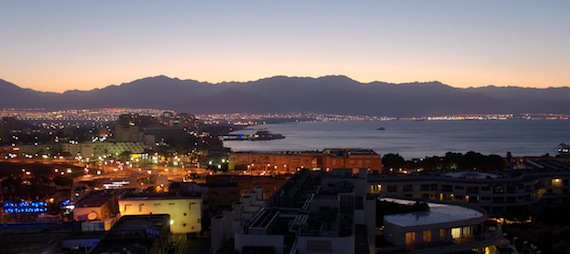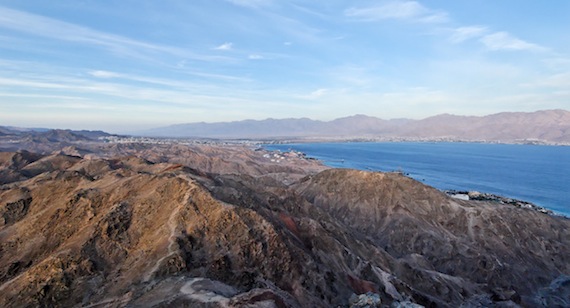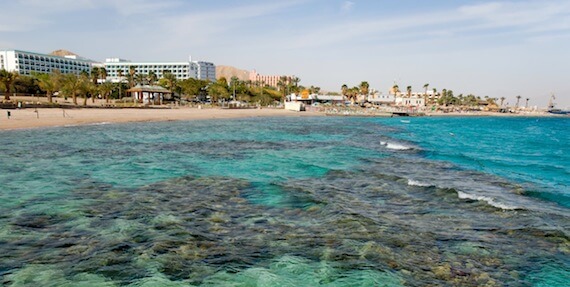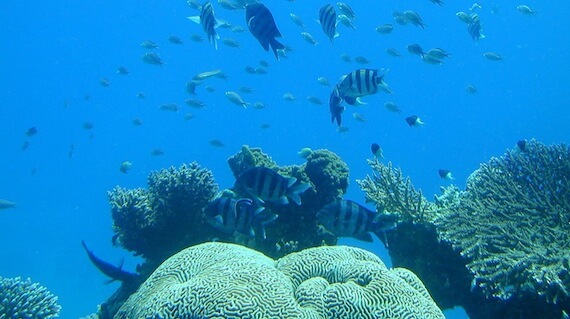When we think of the Red Sea, we tend to picture Moses holding up his arms and dividing the waters. This body of water parted like curtains in the opening act of Israel’s history. The parting of the sea set the stage for one of history’s most incredible escapes (Exodus 14:29-31).

(Photo: Eilat—Israel on the Red Sea. Courtesy of the Pictorial Library of Bible Lands)
But this part of the Red Sea represents only half of its northernmost edges.
The sea has two fingers that point north, divided by the Sinai Peninsula. The more famous finger, the one that parted in the exodus, is the western one—today called the Gulf of Suez.
If the western finger of the Red Sea represented Israel’s beginning as a nation under God, the eastern section, or the Gulf of Aqaba, could embody Israel’s ongoing relationship with the Lord.
And it offers a spiritual lesson for those who will look below the surface.
There’s Eilat of Biblical History
Moses and the children of Israel passed the eastern section of the Red Sea as they circumvented the land of Edom and headed north to the area east of the Jordan River (Numbers 33:35-36; Deuteronomy 2:8). The port cities of that time were Ezion Geber and Elath—from which we get the modern spelling, Eilat.
Eilat, Israel, sits at the northern tip of the Gulf of Aqaba, as did the ancient city.

(Photo: Eilat and Red Sea. Courtesy of the Pictorial Library of Bible Lands)
Often closely associated with Ezion Geber, the cities served as key ports for Israel’s trade with Africa and the Arabian Peninsula.
- King Solomon constructed a fleet of ships at Ezion Geber (1 Kings 9:26-28).
- King Jehoshaphat also assembled ships at Ezion Geber to sail to Ophir, but God scuttled them because of an evil alliance Jehoshaphat had made (1 Kings 22:48; 2 Chronicles 20:35-37).
- Although King Uzziah recaptured Eilat during his reign, the Arameans would later conquer it and remove Judah from controlling the port (2 Kings 14:22; 2 Chronicles 26:1; 2 Kings 16:6).
Eilat, Israel—A Major Port City
Today, the gulf still plays a crucial role as a port city for Israel, a fact easily seen by the many tankers and cargo ships that frequent Eilat. Israel’s imports and exports to and from Asia and East Africa have their touch point in Eilat.
But Eilat is more than a modern port. Much more!
[slideshow id=50]
(All pics courtesy of the Pictorial Library of Bible Lands)
Eilat—Israel on the Red Sea
Since 1949, the State of Israel has transformed Eilat into a beautiful resort city, and it remains the only Israeli town on the Red Sea.
- Beautiful beaches.
- Marine life.
- Snorkeling and scuba diving.
- Bird watching.
- Luxurious hotels.
- The city even has its own airport.
The place literally was built for tourists.

(Photo: Red Sea coral reef at Eilat. Courtesy of the Pictorial Library of Bible Lands)
A Look Below the Surface
The sea is crystal clear and shallow enough to reward any visitor wearing a mask and snorkel with a marvelous peek at one of the richest ecosystems on earth.
- Scuba divers can swim with dolphins at the Dolphin Reef.
- Those preferring to stay dry can still behold the wonders of the sea in a glass-bottomed boat.
- A visit to the Underwater Observatory, south of Coral Beach, allows anyone to stare up close and wide-eyed at a part of creation rarely seen by landlubbers.
- Sharks, sea turtles, sponges, invertebrates, red tropical groupers, and coral reefs, are easily viewed behind glass walls thirty feet below the surface.
- A nearby oceanographic museum educates visitors on the marine life they’ll see. Over 500 species of fish is a lot to take in!

(Photo: Eilat Underwater Observatory, coral and fish. Courtesy of the Pictorial Library of Bible Lands)
Eilat, Israel—Not Just a Secular Scene
Those who come to Eilat might expect a completely secular experience. After all, except for the few biblical references to Eilat as a port, the place seems utterly devoid of anything spiritual.
But it’s not that way for me.
The times I have been to Eilat cause me to marvel at the contrasts I see there.
- The monochrome, barren, and blistering hills that surround Eilat contrast wildly with the colorful and vibrant creation that explodes beneath its waters.
- That vivid difference reminds me of the spiritual life that thrives in the lives of many people who otherwise appear unadorned or even barren.
- As Scripture reminds us, “Though outwardly we are wasting away, yet inwardly we are being renewed day by day” (2 Corinthians 4:16).
Eilat reminds me that there often lies more beneath the surface if we will simply explore.
See Eliat & More In Person
Journey to the Bible Lands with Wayne Stiles. You will NEVER be the same! Learn more:
Tell me what you think: What helps you look below the surface of people to the beauty underneath? To leave a comment, just click here.

